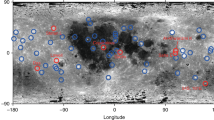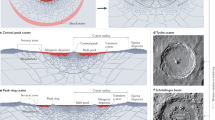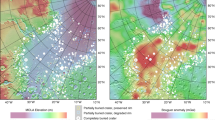Abstract
Tethys, Iapetus and Enceladus, satellites of Saturn, display surfaces which indicate that geological processes have been active suggesting a certain degree of internal evolution. On Iapetus activity seems to have been confined to the dark terrain and its timing and extent remain unknown. The widest variation of terrains and crater numbers occurs on Enceladus and indicates the most prolonged geological activity of any satellite. Activity on Tethys seems confined to the first few hundred million years. The satellite Hyperion and the co-orbitals 1980S1 and 1980S3 show no geological activity and apparently are fragments of once larger bodies.
This is a preview of subscription content, access via your institution
Access options
Subscribe to this journal
Receive 51 print issues and online access
$199.00 per year
only $3.90 per issue
Buy this article
- Purchase on Springer Link
- Instant access to full article PDF
Prices may be subject to local taxes which are calculated during checkout
Similar content being viewed by others
References
Smith, B. A. et al. Science 215, 504–537 (1982).
Plescia, J. B. & Boyce, J. M. Nature 295, 285–290 (1982).
Smith, B. A. et al. Science 212, 163–191 (1980).
Johnson, T. V. & McGetchin, T. R. Icarus 18, 612–620 (1973); Parmentier, E. M. & Head, J. W. Icarus 47, 100–111 (1981).
Soter, S. IAU Planetary Satellite Conf. Ithaca (1974).
Cook, A. F. & Franklin, F. A. Icarus 13, 282–291 (1970).
Shoemaker, E. & Wolfe, R. in The Satellites of Jupiter (ed. Morrison, D.) (University of Arizona Press, 1982).
Yoder, C. F. Nature 279, 767–770 (1979).
Consolmagno, G. J. & Lewis, J. S. Icarus 34, 280–293 (1978); Lupo, M. J. & Lewis, J. S. Icarus 40, 157–170 (1979).
Stevenson, D. J. Nature (submitted).
Peale, S. J., Cassen, P. & Reynolds, R. T. Icarus 43, 65–72 (1980).
Fink, U., Larson, H. P., Gautier, T. N. & Treffers, R. R. Astrophys. J. Lett. 207, L63–67 (1976).
Veeder, G. J. & Matson, D. L. Astr. J. 85, 969–972 (1980).
Lebofsky, L. A., Reike, G. H. & Lebofsky, M. J. Icarus 46, 169–174 (1981).
Author information
Authors and Affiliations
Rights and permissions
About this article
Cite this article
Plescia, J., Boyce, J. Crater numbers and geological histories of Iapetus, Enceladus, Tethys and Hyperion. Nature 301, 666–670 (1983). https://doi.org/10.1038/301666a0
Received:
Accepted:
Issue Date:
DOI: https://doi.org/10.1038/301666a0
This article is cited by
-
Effects of the External Environment on Icy Satellites
Space Science Reviews (2010)
-
Topography and geology of Hyperion
Earth, Moon and Planets (1996)
-
The topography of Janus
Earth, Moon, and Planets (1993)
-
The topography of Epimetheus
Earth, Moon, and Planets (1993)
-
Some unsolved problems in evolutionary dynamics in the solar system
Celestial Mechanics and Dynamical Astronomy (1989)
Comments
By submitting a comment you agree to abide by our Terms and Community Guidelines. If you find something abusive or that does not comply with our terms or guidelines please flag it as inappropriate.



